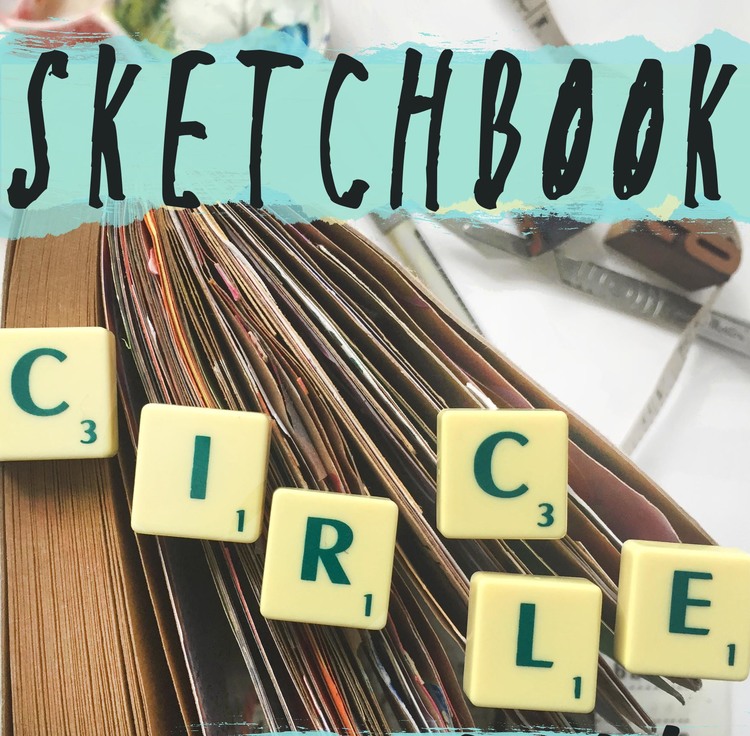Tell us about your work.
I stumbled into teaching straight after completing my BA in Fine Art in 2002, so lost touch with my own practice for a few years, while new routines and responsibilities took over. My creativity found its outlet through my pupils’ work, and I found this to be both rewarding and frustrating in equal measures.
This is my third Sketchbook Circle, and I have noticed that with each collaboration, my work is becoming more adventurous, and I am experimenting more widely with media and techniques.
Although I am currently exploring mixed media, I don’t think I have a particular style or trademark in my work. Even when I was doing my BA, I allowed things to evolve with every new stimulus, responding with whatever materials felt appropriate at the time.
I prefer to create without the restrictions of specialism, media or style, and the Circle allows me to continue working in this way, which in turn, keeps me inspired.
What creative project are you currently working on?
I like to work in series, and some of the pages I have created in the book I share with Yvette are developing into an independent project based around medieval illuminated manuscripts. I originally studied Graphic Design, back in the day, so my love for hand rendered letterforms has returned as a major influence on this body of work.
My collaboration with Suzanne is leading me back to pattern formations and textures, with a more vivid colour palette, and this has led to a series of embellished lino printed postcards, two of which were auctioned recently for NEATEN.
My ‘in progress’ project is another collaboration, this time with my eldest son, Joe. I am responding to his photographic portraits, and although the project is in its very early stages, the long-term plan is to exhibit our work together.
How does your creative process work?
I don’t have much space to work at home, so working in a sketchbook or on smaller pieces suit both the space and time I currently have available.
Working within a given timescale has been highly beneficial; I need structure and deadlines to motivate me, and this has helped me to claim time regularly to make my work.
In my collaborations, I never plan a response until I have seen the work of my sketchbook partner. This keeps the ‘flow’ authentic, and gives me the intensity of thinking/response time I need to be at my most creative. I usually spend 4-5 days just looking at the work, and thinking, before committing to an idea or thread. I then set aside a block of 2-3 days, or the equivalent in evenings, to make, present and collate the work. Quality, uninterrupted time is important, so I need to plan it in advance.
I need to immerse myself completely in whatever creative process I choose to utilise; I find it both meditative and rewarding. I am happy to not have a ‘default’, or ‘go to’ style, as this challenges me.
Having spent so many years worrying about the meaning behind my work, it is refreshing to have the freedom to create work just for the sheer joy of making. The Circle has encouraged me to experiment without fear, to explore the many influences that feed my practice, and to recognise and acknowledge recurring threads. Ideas conceived specifically for the Circle are often developed further into more resolved collections of work, but the starting point is always a sketchbook.
What tools or materials could you not live without?
A sharp scalpel, Derwent Studio coloured pencils, acrylic paints, embroidery silks, and my printer.
Where do you search for creative inspiration?
I live in a beautiful part of the country, I work with some incredibly talented colleagues and young people, and surround myself with like-minded creatives whenever I can. This makes it easy for ideas to emerge, and I always have a list of projects I’d like to get started, if time and space were not such an issue.
I seek out patterns; in nature, in the urban environment, and I am fascinated by anything that plays to my sense of nostalgia. Textiles, wallpaper and ornaments from the ‘70s appeal to my love of kitsch, and while they don’t always directly inform my work in terms of subject matter, there are often colour combinations or motifs that I will lift and reinvent.
I love typography; fairground signs, hand drawn letterforms, vintage advertisements, and these often pop up in my work. I like to work on found or manipulated surfaces, so I can often be found mooching around boot sales or charity shops, looking for interesting starting points.
My local Art College is a reliable source of inspiration, and I often pop in on my way home from school to spy on my ex-pupils!
Pinterest is also a very close friend, and we have spent many long hours together.
What is the best piece of creative advice you have been given?
I am privileged to have been taught drawing by the late Osi Rhys Osmond, during my Foundation Course, and then later during my BA. He was such an inspiring artist and tutor, with so much wisdom and advice. His mantra, however, was always ‘Draw what you see, not what you think is there’, and I often find myself repeating his words in the classroom to my own students.





